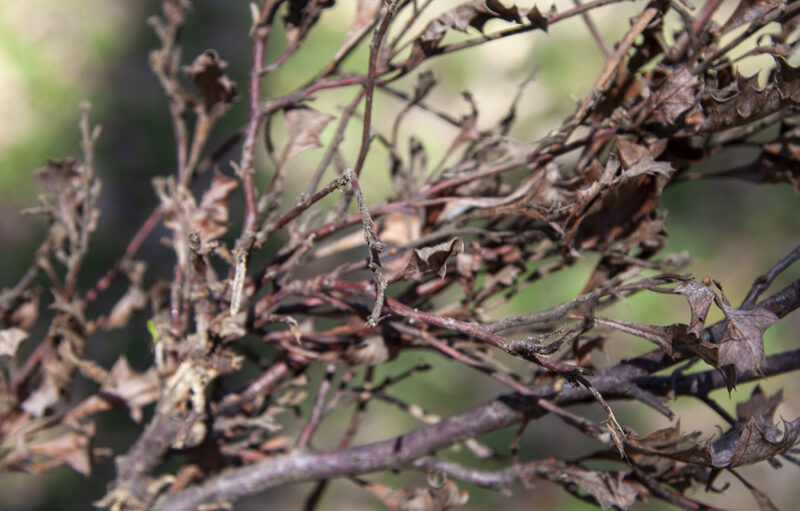PARK WATCH Article December 2023 |
Small pieces of wildlife-rich public reserves and private land form a puzzle that, if connected, can form a new national park, writes Jessie Borrelle, Digital Engagement and Communications Manager
It might not look like it, but that slender string of woodlands on the eastern shores of Western Port Bay, from Lang Lang and Nyora and south to Grantville, is home to some of Victoria’s most endangered wildlife.
The woodlands survived colonisation, becoming stranded as the landscape surrounding it was stripped, burnt and ploughed. Today these last remnants of habitat are being whittled away by sand mining, land clearing, housing developments, climate change and invasive pests.
Sand mines are swelling, consuming the landscape and leaving deep open wounds. Everyday huge sand trucks lumber in and out, robbing the remaining woodlands of its already meagre soil. We know for a fact there are abundant sand supplies available elsewhere; there’s no need to destroy critical habitat here.
Rabbits, foxes and other invasive species are mowing down native grasses and critters. The risk of green-lighting more land clearing for farming, housing and other commercial development puts protection of this wildlife corridor at risk.
Right now the woodlands, particularly on private land, lack even the most basic protection from mining and inappropriate development. Only a very small area is protected.
Connecting the pieces
It doesn’t have to continue like this. We can give Lace Monitors and Grey Goshawks a chance to become common sights among the gums and Austral Grass-trees once again.
Local nature-lovers have worked together for decades to get this area’s natural beauty and significance recognised and to protect it from being mined and cleared.
The Bass Coast was declared a ‘Distinctive Area and Landscape’ in 2019. But this doesn’t mean the woodlands are safe, even though the government’s own ecological experts’ class the Western Port Woodlands as Nationally Significant.
The Victorian Government has designed the Distinctive Areas and Landscapes (DAL) policy draft for the Bass Coast. It proposes a 50-year vision and planning controls to guide land use and development for the region.
Together with South Gippsland Conservation Society and Save Western Port Woodlands we put forward the case for better planning controls for the Woodlands to the DAL hearing panel. Together with ecologists, mycologists, botanists and planning experts, we pushed for science-led future protection of the woodlands.
We’re waiting on a decision from our elected representatives any day now. Meanwhile we continue to work with the community to push for a new Bass Coast National Park to keep this fragile wildlife corridor safe, in perpetuity.
A special glimpse into what once was
Along with the bushland nestled inside the proving track of the former Holden test site, the corridor has some of the most intact original native vegetation in Gippsland.
The sandy soils are rich with wildflowers, including 54 types of orchids. Threatened plants, critically endangered Strzelecki Gums, Grey Goshawks, White-throated Needletails and Eastern Curlews, amongst others, make their homes in the Grass Tree forests, creeks, woodlands and heathlands. Critically endangered Swift Parrots stop to feed here on their migratory journey – and there are only 300-odd individuals left on our planet.
If you’re interested in rare and unusual creatures, the endangered Tea-tree Fingers fungus exists in these woodlands, along with Southern Toadlets, Swamp Antechinus (a little creature similar to a Dunnart) and Giant Gippsland Earthworms.
It’s a hotspot for Southern Brown Bandicoots, whose homes are being destroyed by inappropriate development pushing them closer to local extinction. Likewise for lovers of thick, heathy understoreys – Long-nosed Bandicoots, heavily hit by fires in other areas, and White-footed Dunnarts, a tiny carnivorous marsupial with a white belly and angular snout.
How can we protect this landscape?
We need to maintain and improve links between areas to preserve the integrity of the wildlife corridor. We need to safeguard the surviving coastal forests with better planning controls and reject any expansion of sand mining. In a world facing a man-made climate and biodiversity crisis, these patches of woodlands are more important than ever.
To honour what was and what can be, we must unite these wonder-filled pieces and keep them safe as a new Bass Coast National Park.
VNPA works with the South Gippsland Conservation Society and the Save Western Port Woodlands as the Western Port Woodlands Alliance.
Donate to protect the Western Port Woodlands in a new national park
- Read the latest full edition of Park Watch magazine
- Subscribe to keep up-to-date about this and other nature issues in Victoria
- Become a member to receive Park Watch magazine in print
